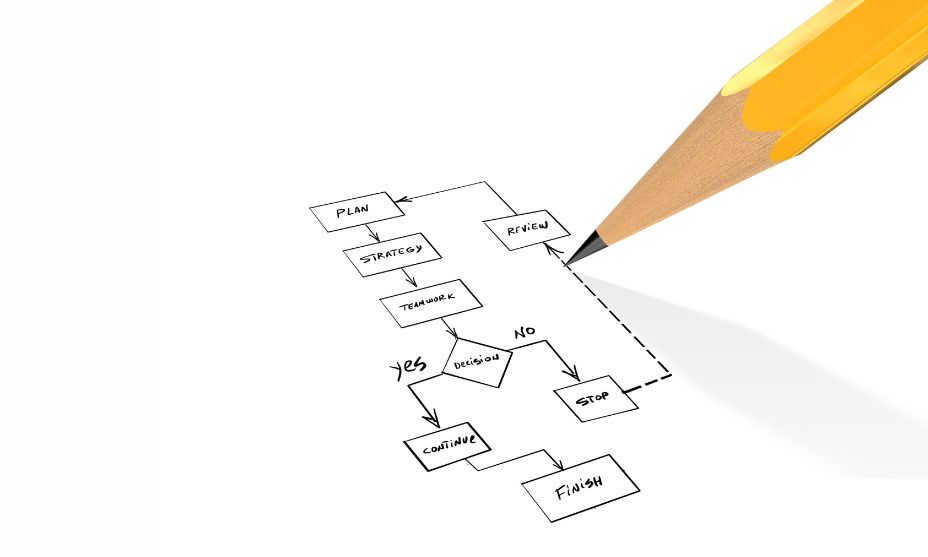Evaluating Business Options: Decision Tree Diagrams for Strategic Planning

In the dynamic landscape of strategic planning, decision-making can be a complex puzzle. But you can use decision tree diagrams, a powerful tool that brings clarity and structure to the decision-making process.
A decision tree is similar to a flow chart but is used to visualize a decision-making process instead of documenting workflows and processes. Like flowcharts, decision trees outline different action plans and their potential outcomes. In this way, they provide a robust framework for making the right decisions and an organized approach to exploring all available options.
They are helpful in strategic planning because they allow business leaders to outline and understand potential outcomes, costs, and consequences of different complex decisions. They also help leaders predict the probability of successful outcomes depending on the paths they choose. This article will explore how to use decision trees to evaluate different business options during strategic planning.
Using Decision Tree Diagrams for Strategic Planning
Define the Objective and Identify the Major Decision
A decision tree has a root node, branches, and leaves. The root node should identify the main objective you are trying to reach or the decision you are trying to make. In strategic planning, this will be the vision for the future or the desired outcome.
You should be very specific at this point because this will form the basis of the evaluation. Identifying your objectives and major decisions will also make it much easier to identify the goals and objectives you need to achieve or meet for your strategic planning to be successful.
When doing this, you can also start with a question or choice you are facing. Perhaps you have two strategies, like hiring more people to increase sales or cutting expenditures to improve cash flow. Either can lead to business growth, but they are vastly different, and their implementation will be different, so you need to choose correctly.

Create Your Branches
Now you can start creating the decision tree. You do not have to draw one from scratch, though, because you can use a decision tree template as a starting point. Once you have outlined your objective or major decision as your root node, the next step is drawing arrows that indicate the different branches. Each arrow or branch will indicate a possible option. They can also indicate the different decisions you need to make to achieve the plan’s objective.
Consider adding notes that detail the costs and risks associated with each branch. Doing this will help you better understand the pros and cons of each decision, so you know where to start leaning as you go through this process.
Come Up with Possible Alternatives
It is also a good exercise to list possible alternatives for each branch or decision. In some cases, you may find that your plans about reaching your strategic planning goals and objectives will not work out as intended. If you already have alternatives, you could explore them to see if they will lead to the desired outcomes.
Attach Leaves to Branches
The leaves are the results you expect from each branch. Use different symbols for additional decisions and uncertain outcomes. For example, you may find that a possible action will require more thought and research to understand its possible repercussions. The results of following a specific course of action might also be uncertain, requiring more data and research to reach a conclusive decision. Remember that the results or outcomes may be positive or negative, so you should indicate this in your decision tree.
Assign Probabilities of Outcomes
Additional research will help you identify the probability of success of each decision on your tree. Assign probabilities of success based on the likelihood of an outlined outcome occurring. This will involve estimating the chances of each outcome depending on external factors, the decision itself, and other factors you realize as you do your research.
Lastly, attach weights or values to each outcome to represent their importance or impact on the plan’s objectives and goals.
Evaluate Different Paths
With the tree and the nodes, data information, and decision points it contains, you can start evaluating different paths and the consequences of each. This exercise will help you understand the rewards and risks of each, and, therefore, the most favorable path or alternative to follow.

Make the Decision
The final step is picking the decision that leads to the required outcome with as little risk and as much reward as possible. You should also monitor your decisions once implemented to see if they lead to the desired outcome. If not, you might have to restart the process.
Decision trees are powerful for making decisions required when making a strategic plan for your business. They allow you to visually represent every decision, its alternatives, possible outcomes, and potential impact to make the right one and achieve your goals and objectives.
Advantages of Decision Tree Diagrams in Strategic Planning
What sets decision tree diagrams apart in the world of strategic planning are their multiple advantages.
Flexibility and Adaptability: Decision tree diagrams are not rigid structures. They adapt to changing circumstances, allowing organizations to pivot their strategies in response to unforeseen events.
Visual Representation for Clarity: The visual nature of decision tree diagrams simplifies complex scenarios. Decision-makers can quickly grasp the implications of each choice, fostering a deeper understanding of the strategic landscape.
Risk Assessment: By assigning probabilities to outcomes, decision tree diagrams enable organizations to assess and manage risks effectively. This proactive approach enhances the resilience of strategic plans.
Final Words
As you move towards your strategic planning endeavors, consider the power of decision tree diagrams as your strategic companions. Embrace their visual language, navigate the branches of choices, and let the leaves of potential outcomes guide you to informed and impactful decisions.




